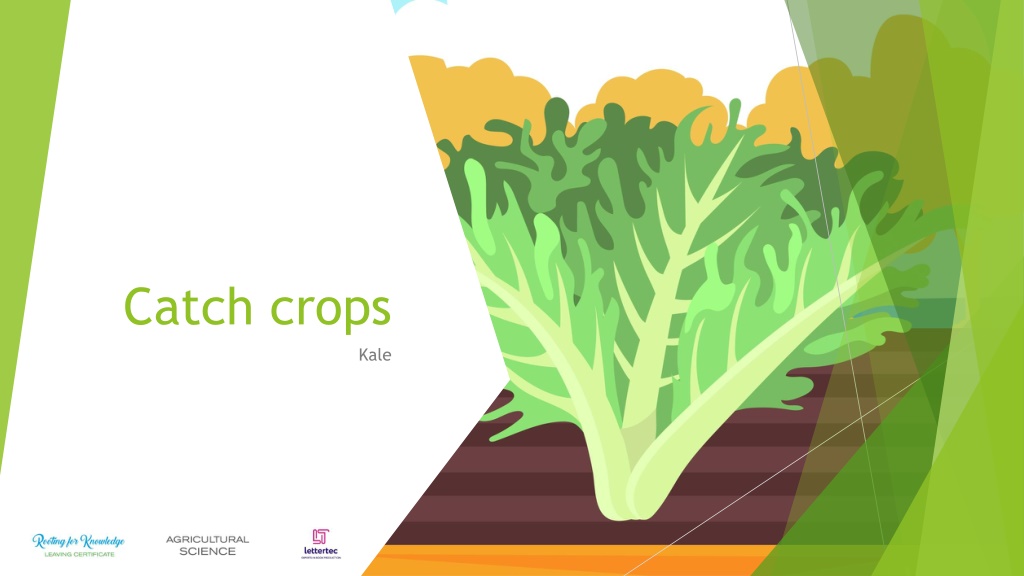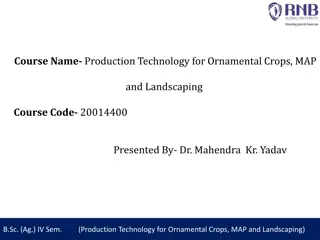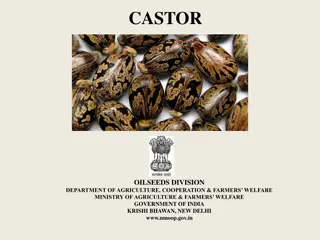Understanding Catch Crops and Kale Cultivation
Catch crops are fast-growing crops cultivated during fallow periods, offering advantages like providing additional winter fodder and preventing nitrogen leaching. Kale, a popular catch crop, has a biennial growth cycle and various varieties with different characteristics. Factors like soil suitability and pest management play crucial roles in successful Kale cultivation. Learning about seed selection, growth cycles, and cultivation practices can enhance your understanding and help maximize the benefits of growing Kale.
Uploaded on Sep 09, 2024 | 0 Views
Download Presentation

Please find below an Image/Link to download the presentation.
The content on the website is provided AS IS for your information and personal use only. It may not be sold, licensed, or shared on other websites without obtaining consent from the author. Download presentation by click this link. If you encounter any issues during the download, it is possible that the publisher has removed the file from their server.
E N D
Presentation Transcript
Catch crops Kale
Learning Outcomes You should be able to: Explain what catch crops are Discuss Advantages and Disadvantages of growing catch crops Describe the growth cycle of Kale Name and describe characteristics of Kale varieties List factors that contribute to seed selection of Kale Describe the cultivation of Kale under the following headings: Rotation, Soil Suitability, Soil Preparation, Fertilisers, Weed Control Name and describe the effects of pests of Kale Describe the effects of Club Root Discuss uses of Kale Discuss benefits of Kale View Kale through the lenses Health and Safety and Sustainability
Fast growing crops that are grown when a field would usually be idle. Usually cultivated for livestock feed Catch crops Ploughing a catch crop back into the soil can improve soil structure
High yield for the time grown Fast growing Advantages Provide additional winter fodder Provides the soil with a break between crops of similar types Helps to prevent Nitrogen leaching
Labour Intensive Many are low in fibre so they cannot replace hay or silage Uneconomical to remove a productive pasture Disadvantages Risk of poaching if grazing over the winter months
Kale Sown between early May and mid June Grows for 5-6 months Deep root system which reduces risk of being affected by drought
Growth cycle Biennial plant Usually grazed at approx. 6 months Growth cycle Seed Seedling Vegetative Mature
Seed Selection Variety Characteristics Grampian Very high yield Club root tolerant Excellent digestibility The choice of seed can be affected by: Intended use Availability Disease Resistance Keeper High yield Good lodging resistance High DM% Maris Kestrel High quality feed Excellent leaf:stem ratio High yield Highly digestible Yield DM content
Rotation Kale is prone to club root Should be grown in a 5 year rotation Fertiliser Requirements Soil tests should be done to determine fertiliser requirements Compound fertilisers can be used
Kale needs: Deep, well-drained soils (loam) with a pH between 6 and 7 Soil should be ploughed and harrowed Sown between April and July Cultivation Seed can be broadcast or planted by direct drilling - 4-5kg/ha Roll soil after spreading seed Ensures good seed-soil contact Early Sown crops have higher yields Warmer temperatures during the growing season
Good preparation of soil promotes quick emergence of Kale This leads to a well-established Kale crop Reduces weeds Weed Control Herbicide can also be used If grown after pasture pre-emergent herbicide can be used to reduce broadleaf weeds
Pests Flea Beetles Thrive in warm, dry conditions Cause damage to stems and leaves which can kill seedlings Diamondback Moth Lays eggs on the underside of the leaves Caterpillars feed on the leaves causing damage Can be controlled with a contact insecticide
Diseases Club Root affects Kale and other Brassicas. Caused by a soil borne fungus. Cannot be treated with a fungicide. Causes the root to swell and reduces water and nutrient uptake. Grow poorly, wilt and have a reduced yield. Prevent using crop rotation and resistant varieties.
Uses of Kale Kale can be grazed rotationally or zero grazed. Kale can also be conserved as kaleage (prepared the same way as silage) Animals should be introduced onto kale slowly and it should form no more than 30/35% of an animal's dry matter intake Excessive intake can lead to anaemia and nutritional red water (damage to red blood cells) There should access to roughage (silage or hay)
Allows livestock to outwinter => Reduces winter housing costs Reduces labour and costs of producing silage Benefits High crude protein content Acts as a cover crop preventing soil erosion and nitrogen leaching
Health and Safety Care should be taken with machinery Protective clothing (PPE) should be worn when spraying chemicals Care should be taken when moving livestock for grazing
Sustainability Kale acts as a cover crop Prevents soil erosion and nitrogen leaching Can be grown in crop rotation























